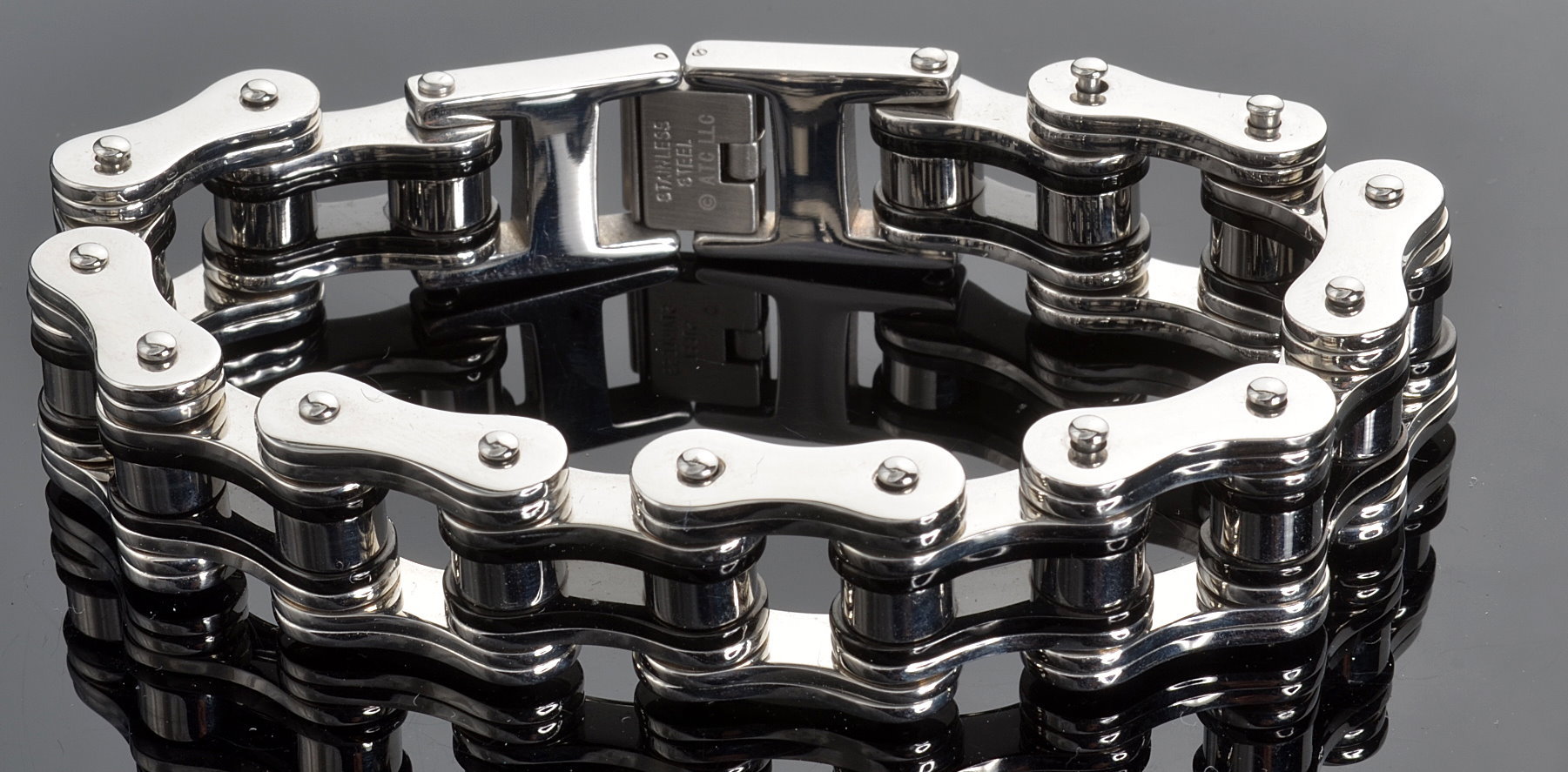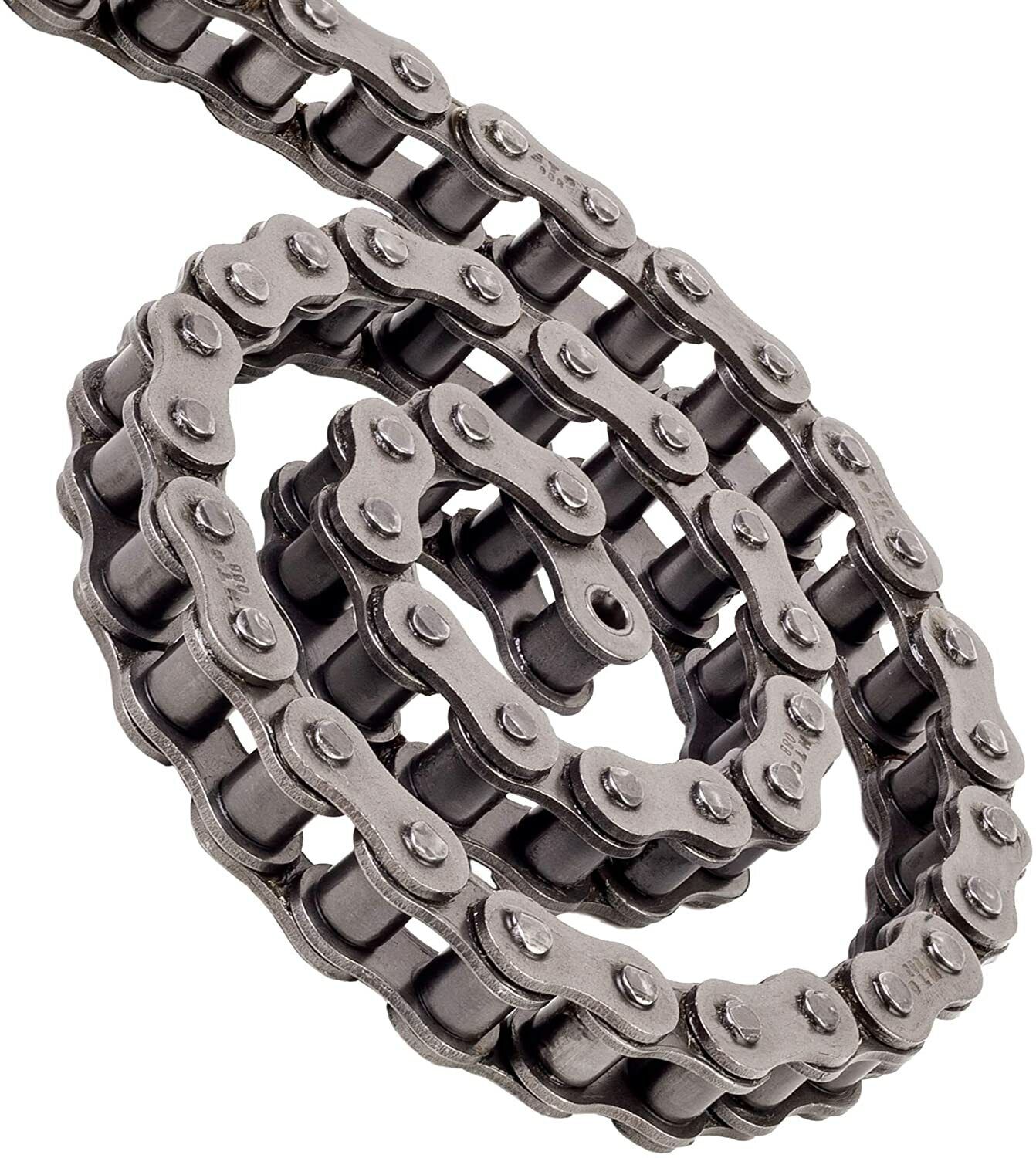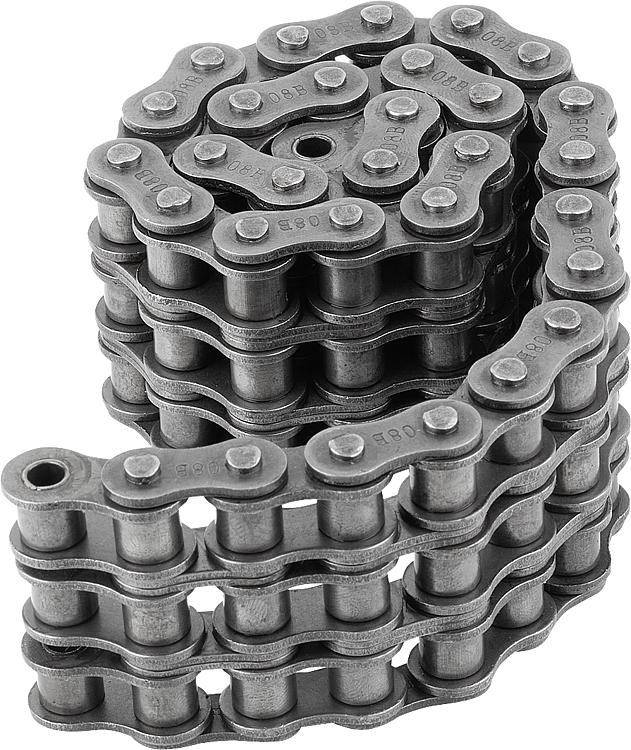Roller chains or bushed roller chains are most commonly used in various types of household, industrial and agricultural machinery such as conveyors, wire drawing machines, printing presses, automobiles, motorcycles, etc. It is a chain drive type used. bike. It consists of a series of short cylindrical rollers held together by side links. It is driven by gears called sprockets. It is a simple, reliable and efficient way of transmitting electricity. A 16th-century sketch by Leonardo da Vinci shows a chain with roller bearings. In 1800, James Fassel patented a roller chain that developed a counterbalance lock, and in 1880, Hans Reynold patented a Bush roller chain.
put up
Bushed roller chains have two types of links arranged alternately. The first type is the inner link, where the two inner plates are held together by two sleeves or bushings that rotate two rollers. Inner links alternate with a second type of outer link, consisting of two outer plates held together by pins passing through inner link bushings. “Bushless” roller chains are constructed differently but operate similarly. Instead of separate bushings or sleeves holding the inner panels together, the panels are stamped with tubes that protrude through holes and serve the same purpose. This has the advantage of eliminating a step in chain assembly. The roller chain design reduces friction, which increases efficiency and reduces wear compared to simpler designs. The original drive chain had no rollers or bushings, and both the inner and outer plates were held together by pins that made direct contact with the sprocket teeth. However, in this configuration I found that the sprocket teeth and the plate on which the sprocket teeth rotated wore out very quickly. This problem was partially solved by the development of sleeve chains, in which the pins holding the outer plates pass through bushings or sleeves connecting the inner plates. This distributes the wear over a wider area. However, the sprocket teeth are still wearing faster than expected due to sliding friction with the bushings. The added rollers surrounding the chain bushing sleeve provide rolling contact with the sprocket teeth and also provide excellent wear resistance to the sprocket and chain. As long as the chain is well lubricated, friction is very low. Continuous clean lubrication of roller chains is essential for efficient operation and correct tension.
lubricating
Many drive chains (such as camshaft drives in factory equipment and internal combustion engines) operate in clean environments so that their wearing surfaces (i.e. pins and bushings) are not affected by settled and suspended sediment, and many are closed environments For example, some roller chains have a built-in O-ring between the outer link plate and the inner roller chain plate. Chain manufacturers began adopting this feature after Joseph Montano, who worked for Whitney Chain in Hartford, Connecticut, invented the application in 1971. O-rings were introduced as a method of improving lubrication of power transmission chain links, which is important for extending chain life. These rubber retainers create a barrier that keeps the factory-applied grease within the wear areas of the pin and bushing. Additionally, rubber O-rings prevent dust and other contaminants from entering the chain joints. Otherwise, such particles can cause severe wear. There are also many chains that must operate in dirty conditions and cannot be sealed due to size or operational reasons. Examples include chains used on farm equipment, bicycles, and chainsaws. These chains inevitably have a relatively high wear rate. Many oil-based lubricants attract dust and other particles, eventually forming an abrasive paste that increases chain wear. This problem can be alleviated by using “dry” PTFE spraying. It forms a strong film after application that blocks both particles and moisture.
Motorcycle chain lubrication
Use an oil bath with a chain that runs at a high speed equivalent to a two-wheeled vehicle. This is not possible on modern motorcycles, and most motorcycle chains run unprotected. Therefore, motorcycle chains tend to wear out quickly compared to other uses. They are subjected to extreme forces and exposed to rain, mud, sand and road salt. The bicycle chain is the part of the drivetrain that transfers the power from the motor to the rear wheel. A properly lubricated chain can achieve over 98% transmission efficiency. An unlubricated chain will significantly reduce performance and increase chain and sprocket wear. There are two types of aftermarket motorcycle chain lubricants available: spray lubricants and drip systems. Spray lubricants may contain wax or Teflon. These lubricants use sticky additives to stick to your chain, but they also create an abrasive paste that pulls dirt and grit from the road and accelerates component wear over time. Continuously lubricate the chain by dripping oil, using light oil that does not stick to the chain. Research shows that drip oil supply systems provide maximum wear protection and maximum energy savings.
Variants
If the chain is not used for high-wear applications (for example, simply transmitting motion from a hand lever to a control shaft of a machine, or a sliding door on an oven), a simpler type is used. The chain can still be used. Conversely, a chain may “bump” when extra strength is needed, but needs to be driven smoothly at smaller intervals. Instead of placing only 2 rows of plates on the outside of the chain, it is possible to place 3 (“double”), 4 (“triple”) or more rows of parallel plates, with bushings between adjacent pairs and rollers. Teeth with the same number of rows are arranged parallel and matched on the sprocket. For example, a car engine timing chain usually has multiple rows of plates called chains. Roller chains come in a variety of sizes, with the most common American National Standards Institute (ANSI) standards being 40, 50, 60, and 80. The first number indicates the spacing of the chain in 8-inch increments, and the last number is 0. 1 is for a standard chain, 1 for a lightweight chain, and 5 for a sleeve chain without rollers. So a chain with a 0.5 inch pitch is a size 40 sprocket, while a size 160 sprocket has 2 inches between teeth, and so on. Metric thread pitch is expressed in sixteenths of an inch. Therefore, Metric No. 8 chain (08B-1) is equivalent to ANSI No. 40. Most roller chains are made from plain carbon or alloy steel, but stainless steel is used in food processing machinery and other places where lubrication is an issue. , we also sometimes see nylon and brass for the same reason. Roller chains are usually connected using master links (also called “connecting links”). This main link usually has a pin held in place by a horseshoe clip rather than a friction fit and can be inserted or removed with a simple tool. Chains with removable links or pins are also called adjustable split chains. Half links (also called “offsets”) are available and are used to increase chain length with a single roller. Riveted Roller Chains The ends of the main links (also called “connecting links”) are “riveted” or crushed. These pins are durable and cannot be removed.
horseshoe clip
A horseshoe clamp is a U-shaped spring steel attachment used to secure the side plates of the connecting (or “master”) link that was previously necessary to complete the roller chain link. The clamp method is falling out of favor as more and more chains are made to be endless loops that are not intended for maintenance. Modern motorcycles tend to be equipped with endless chains, but it is increasingly rare for the chain to wear out and need to be replaced. Available as spare part. Modifications to motorcycle suspensions tend to reduce this use. Commonly found on older motorcycles and older bikes (such as those with hub gears), this clamp method cannot be used on bikes with derailleur gears as the clamps tend to get stuck in the shifter. In many cases, the endless chain is fixed to the frame of the machine and cannot be easily replaced (this is especially true for traditional bicycles). However, in some cases, coupling links using horseshoe clamps may not work or be preferred by the application. In this case, a “soft link” is used, which relies only on friction using a chain riveting machine. Using the latest materials, tools, and skilled techniques, this repair is a permanent fix that is nearly as strong and lasts as long as an unbroken chain.
use
Roller chains are used in low to medium speed drives with speeds of approximately 600 to 800 feet per minute. However, at high speeds, about 2,000 to 3,000 feet per minute, V-belts are often used due to wear and noise issues. Bicycle chain is a type of roller chain. Your bike chain may have a master link, or it may require a chain tool to remove and install. Most motorcycles use a similar, larger, stronger chain, but this is sometimes replaced with a toothed belt or shaft drive that produces less noise and requires less maintenance. Some automotive engines use roller chains to drive camshafts. Gear drives are commonly used in high-performance engines, and some manufacturers have used toothed belts since the early 1960s. Chains are also used in forklifts that use hydraulic rams as pulleys to raise and lower the truck. However, these chains are not considered roller chains but are classified as lift chains or plate chains. Chainsaw cutting chains are superficially similar to roller chains but are more closely related to leaf chains. They are driven by protruding drive links and also serve to position the chain on the bar. Perhaps unusually using a pair of motorcycle chains, the Harrier Jumpjet uses a chain drive from an air motor to rotate a movable engine nozzle that points downward for hover flight and rearward for normal I can. Forward flight, a system called “thrust vectoring.
wear
The effect of roller chain wear is to increase the pitch (the distance between the links) and lengthen the chain. Note that this is due to wear on the pivot pin and bushing, not actual elongation of the metal (which happens with some flexible steel parts, such as car handbrake cables). like). With modern chains, it is rare for a (non-bike) chain to wear to the point of failure. As the chain wears, the sprocket teeth begin to wear out rapidly and eventually break, resulting in the loss of all sprocket teeth. Sprocket teeth. The sprocket (especially the smaller of the two sprockets) undergoes a grinding motion that creates the characteristic hook shape on the driven surface of the teeth. (This effect is exacerbated by improper chain tension, but is unavoidable no matter what precautions are taken). Worn teeth (and chains) will not be able to transmit power smoothly, which will be evident in noise, vibration, or (in the case of car engines with timing chains) changes in ignition timing seen through the timing light. A new chain on a worn sprocket won’t last long, so in this case both the sprocket and chain will need to be replaced. However, in less severe cases, you can save the larger of the two sprockets. This is because the smaller sprockets always wear the most. Chains usually only pop out of the sprockets in very light applications (like bicycles) or in extreme cases of insufficient tension. The chain wear elongation is calculated according to the following formula: % = ( ( M. − ( S. * P. ) ) / ( S. * P. ) ) * 100 {\displaystyle \%=((M-(S*P ))/(S*P))*100} M = Length of number of measured links S = Number of measured links P = Pitch It is common in the industry to monitor the movement of the chain tensioner (whether manual or automatic) and the accuracy of the drive chain Length (a rule of thumb is to stretch the rollers 3% in an adjustable drive to replace the chain or stretch the roller chain 1.5%) % (in a fixed center drive). A simple method, especially suitable for bicycle and motorcycle users, is to pull the chain off the larger of the two sprockets when the chain is taut. Significant movement (visible through gaps, etc.) may indicate that the chain has reached or exceeded its ultimate wear limit. Ignoring this problem may damage the sprocket. Sprocket wear can counteract this effect and mask chain wear.
Bicycle chain wear
Lightweight chains on bikes with derailleur gears can break because the inner pin is barrel-shaped instead of cylindrical (or rather, in the side plate, since “riveting” is usually the first to fail). may come off). The contact between the pin and bushing is a point rather than the usual line, causing the chain’s pin to pass through the bushing and eventually the roller, ultimately causing the chain to break. This structure is necessary because the shifting action of this transmission requires the chain to bend and twist sideways, but is due to the flexibility and relatively long freedom of such a thin chain on the bike. length may occur. Chain failure is less of an issue in hub gear systems (Bendix 2 speed, Sturmey-Archer AW, etc.) because the wear surface in contact with the parallel pin bushings is much larger. The hub gear system also allows for a complete housing, which greatly aids in lubrication and sand protection.
Chain strength
The most common measure of roller chain strength is tensile strength. Tensile strength indicates the amount of a single load a chain can withstand before breaking. Chain fatigue strength is as important as tensile strength. The key factors that affect the fatigue strength of the chain are the quality of the steel used to manufacture the chain, the heat treatment of the chain components, the quality of the chain plate knot hole processing, the type of shot and the strength of the shot peening coating. on the link board. Other factors may include chain plate thickness and chain plate design (profile). For roller chains operating in continuous drives, a rule of thumb is that the load on the chain should not exceed 1/6 or 1/9 of the chain’s tensile strength, depending on the type of master link used (press-fit or slip-on ). must fit). Roller chains operating in continuous drives above these thresholds can, and often do, fail prematurely due to fatigue failure of the chain plates. The standard minimum ultimate strength for ANSI 29.1 steel chains is 12,500 x (pitch in inches)2. X-ring and O-ring chains feature internal lubricants that significantly reduce wear and extend chain life. Internal lubricant is injected via vacuum when riveting the chain.
chain standard
Standards organizations such as ANSI and ISO maintain standards for drive chain design, dimensions, and interchangeability. For example, the table below shows data from ANSI Standard B29.1-2011 (Precision Roller Chains, Accessories, and Sprockets) developed by the American Society of Mechanical Engineers (ASME). See Resources for details. To help you remember, here’s another chart of the key dimensions (in inches) for the same standard (which is part of what you consider when choosing the numbers recommended by the ANSI standard): Typical bicycle chain (for derailleur gears ) Use narrow 1/2 inch pitch chain. Chain width is variable without affecting load capacity. The more sprockets you have on the rear wheel (used to be 3-6, now 7-12), the thinner the chain. Chains are sold based on the number of speeds they are designed to work at, such as a “10-speed chain.” Hub gear or single speed bikes use a 1/2 x 1/8 inch chain. 1/8 inch refers to the maximum sprocket thickness that can be used on a chain. Chains with parallel links usually have an even number of links, with each narrow link followed by a wider link. Chains made with uniform links that are narrow at one end and wide at the other can be made with an odd number of links, which is advantageous for accommodating special sprocket distances. For one thing, such chains tend to be less strong. Roller chains manufactured to ISO standards are sometimes called “isochains”.
Post time: Nov-06-2023





